What is DBT?
Dialectical Behavior Therapy (DBT) is a compassionate type of behavioral therapy that is intended to help people move towards having a life that feels more meaningful and worth living. It is an evidence-based treatment that has proved effective for anxiety disorders, mood disorders, personality disorders, addictive disorders and impulse control disorders. By combining standard cognitive-behavioral techniques for emotion regulation with the concepts of distress tolerance, acceptance and mindfulness, the skills taught by DBT strengthen a person’s ability to handle their emotions without losing control or engaging in destructive behavior.
Combining several therapeutic approaches, DBT was originally designed for severe mental illness (people engaging in self harm or with chronic suicidal thoughts). Research shows that DBT can be extremely effective in less severe areas, such as anxiety, mild depression, relationship conflict – in essence: wherever there is a need to regulate emotions. Once learned, these skills can be applied in our everyday lives, including stress related to work, family relationships, and medical conditions. DBT was designed by Marsha Linehan, Ph.D., beginning in the 1970s. Dr. Linehan pulled from effective treatments such as cognitive behavioral therapy, assertiveness training, validation strategies, and Buddhist mindfulness meditations. Dr. Linehan then went on to study DBT in clinical trials, showing that DBT is, in fact, extremely effective in the treatment of patients with chronic suicidal thoughts. Other clinicians have furthered her research into other areas.
Why DBT?
DBT is an evidence-based modality which has been proven effective in helping people:
- Understand and manage overwhelming emotions
- Learn more about themselves and how they think
- Reduce emotional instability and impulsive behaviors
- Learn more effective ways of coping with stress
- Improve relationships and identify effective relationships in their life
Who benefits from DBT?
DBT teaches skills useful to pretty much everyone. These include skills like learning to accurately recognize emotions in you and others, tolerating difficult emotions, and engaging with others effectively.
How is DBT different from standard therapy?
When most people think of therapy, they think of interpersonal therapy, where you talk about your feelings and your past. While DBT employs much of the change process involved in standard Cognitive Behavior Therapy (CBT), the use of validation/acceptance is added. DBT, like most behavioral therapies, meets you where you are in the current moment; focusing on helping you change ineffective ways of coping by learning new, skillful ways to deal with situations. By validating the client, the therapist is able to reinforce the dialectic: the idea that seeming opposites can coexist and be synthesized. This means weighing out various points of view in any situation by constantly balancing the ideals of acceptance and change, and assists in creating a life worth living for the client. By the teaching of skills, DBT relies on specific goals that can realistically be attained. At times DBT is referred to as a “doing” therapy rather than a “talking” therapy. While DBT does ultimately focus on past experiences, the first steps of treatment are spent ensuring that the client is effective in communication and a relationship is established.
It is recommended that the client read the “What is DBT?” page on Behavioral Tech’s website for further understanding the development of and research into Dialectical Behavior Therapy.
